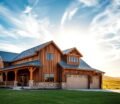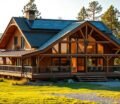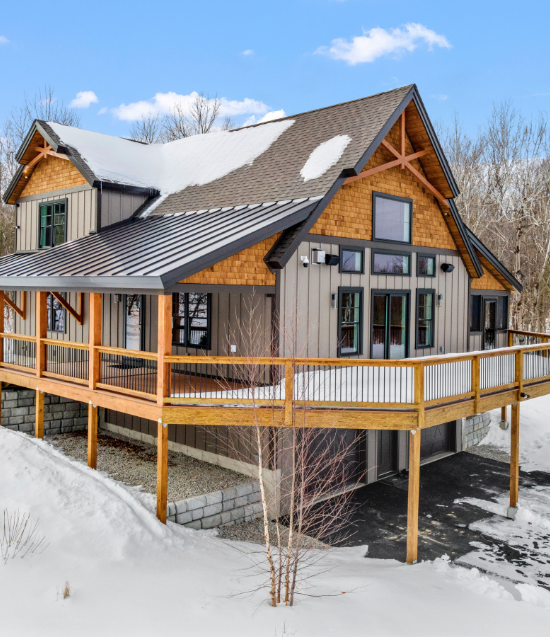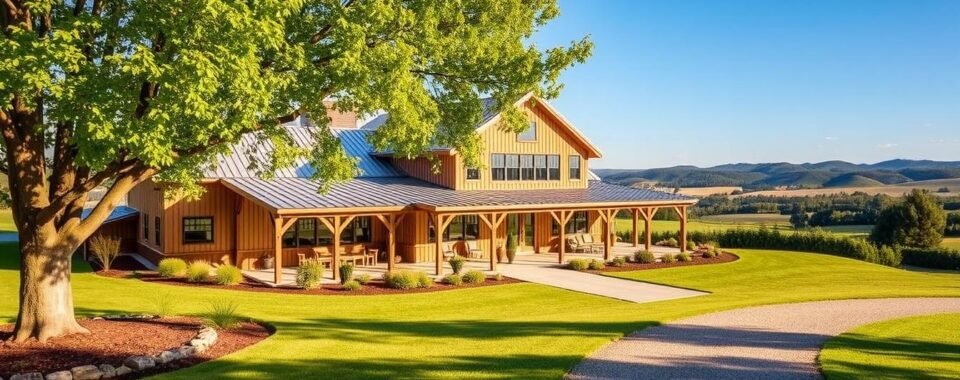

An engineering professor once visited a rural build site with a team. He said, “This idea needs a plan that builds.” The team had sketches and big dreams but no clear path to permits. This visit changed everything, focusing on making the plans workable.
Our goal is simple: to help you turn your ideas into real, code-compliant buildings. We show how Custom Barndominium Plans and designs blend technical skill with creativity. This way, your design meets all the necessary checks and stays within budget.
For nearly 20 years, companies like Barndo Plans and Barndo & Co. have made safe, build-ready plans for all 50 states. We share how to get quick drafts, make changes, and get the right permits to avoid costly mistakes. We also talk about different ways to get your plans, from basic to fully managed, to fit your budget and needs.
In this article, we’ll mention useful tools and services. These include structural engineering help and ways to see your barndominium before it’s built. For more help, contact Barndo Plans at Barndo Plans or email info@barndoplans.com and call +1-844-963-9963.
Understanding Barndominiums and Their Appeal
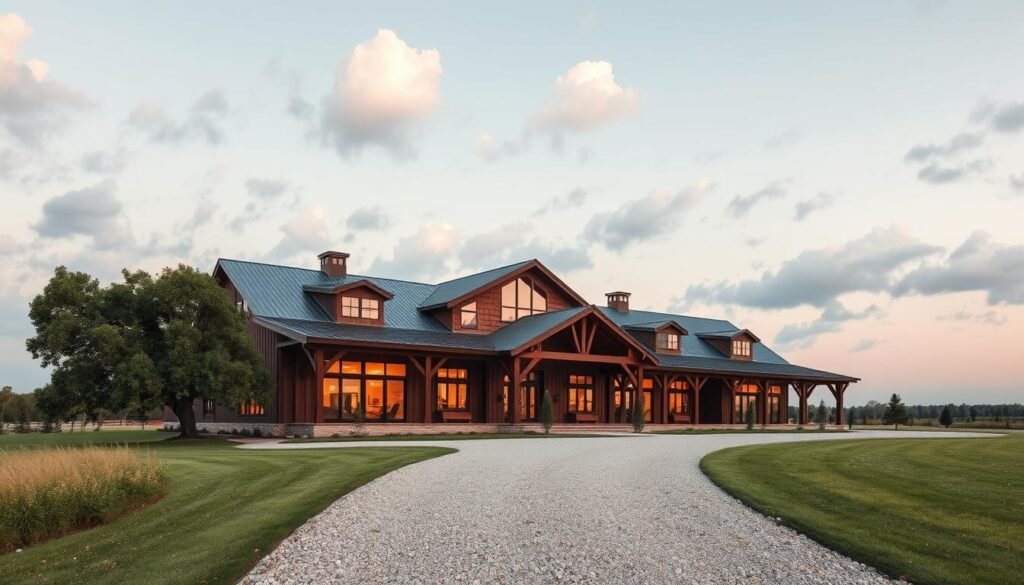
We dive into why barndominiums are a top pick for today’s homeowners and builders. We look at what they are, their benefits, and common design features. This helps professionals and students decide if a barndominium is right for their project.
What is a Barndominium?
A barndominium mixes old barn building with modern living. It uses frames like post-frame, post-and-beam, or steel red-iron. These frames impact how the building stands, keeps warm, and lasts over time.
Inside, you’ll find open spaces, areas for workshops or garages, and flexible layouts. Companies like Barndo Plans say it’s about combining useful space with cozy living areas.
The Benefits of Building a Barndominium
Building one is cost-effective, with prices from $100 to $150 per square foot. For fancy homes, prices can go up to $200 per square foot. This gives a good starting point for budgets.
They’re also quick to build, thanks to metal and post-frame systems. Companies like Barndo & Co. and JL Barndominium Artists focus on simple plans. This cuts down on changes and delays.
They’re also flexible. Big open spaces let you mix living areas, workshops, and garages without extra walls. Getting financing and finding land is easier too.
Popular Design Features
Popular features include open layouts, high ceilings, garage or workshop areas, and wide porches. Metal siding with wood or cedar adds a nice look: strong and cozy.
We use 3D designs and tools to check if a design works before building. These tools help talk to clients and avoid changes later.
The Process of Creating Custom Plans
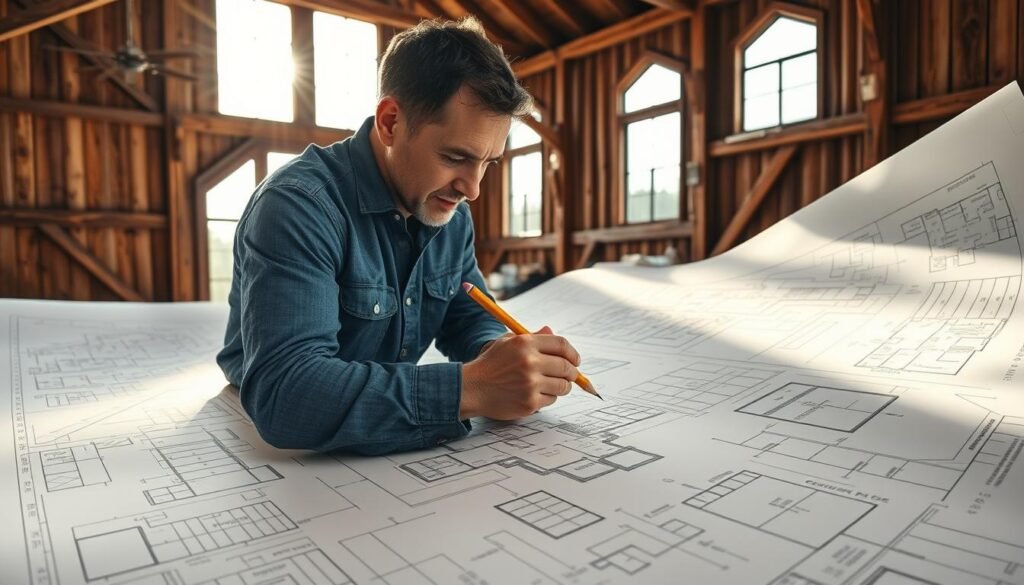
We help clients create Custom Barndominium Plans. We start by understanding their needs and goals. This helps us plan timelines, budgets, and permits.
Assessing Your Needs and Preferences
We first review the site: topography, soils, and orientation. Then, we look at what you need: square footage, bedrooms, and special areas. We also consider your long-term plans.
We plan in stages to match design with land and finance. This includes Exploration, Commitment, Preparation, and Execution phases. It helps set clear goals and milestones.
Collaborating with a Designer
Choosing an experienced designer saves time and money. Companies like Barndo Plans offer quick drafts and detailed permits. This speeds up approvals.
We focus on clear communication. We provide initial sketches, detailed drawings, and unlimited revisions. When working with a designer, check their references and code knowledge.
Budget Considerations
We use budget ranges: $100–$150 per square foot for basic, and $200+ for custom. This helps clients choose the right package.
Package choices affect costs and risks. DIY shells save money but require more work. Fully Managed packages cost more but are less stressful. We include fees for permits and site prep to avoid surprises.
Changing plans late can increase costs. JL and industry experts say it can cost 5–10 times more. We plan carefully to meet your budget and goals.
For clear plan options and pricing, check Barndo Plans. They explain their policies and pricing.
Essential Elements of Custom Barndominium Plans
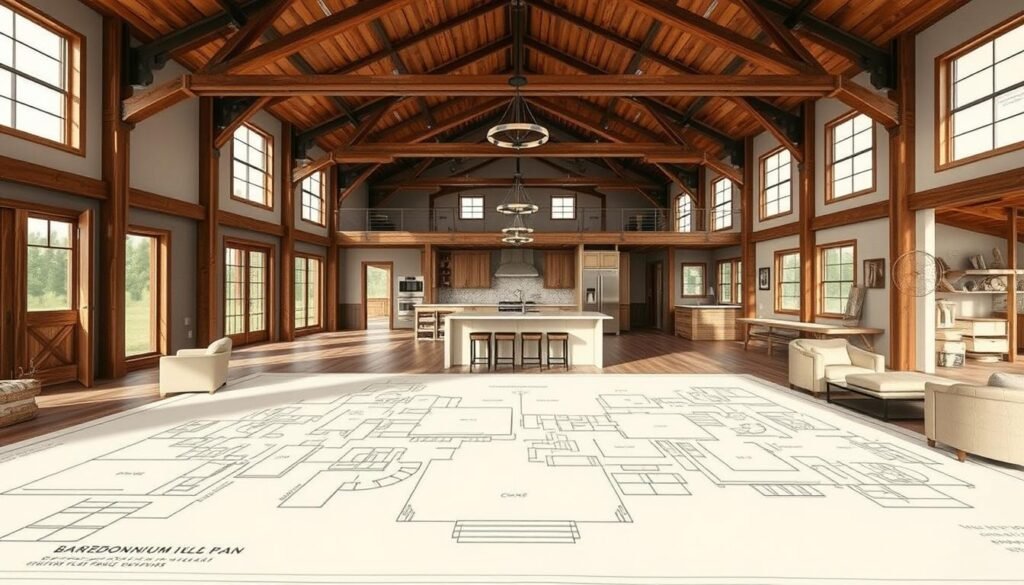
We start by framing the core pieces every build-ready set must include. Clear documentation speeds permits and reduces field changes. Good plans link form and function so living spaces and work zones coexist without compromise.
Floor Plans and Layouts
Deliverables should show dimensioned floor plans, reflected ceiling plans, and window and door schedules. We map functional adjacencies so bedrooms, kitchens, and garages sit logically next to workshops and storage.
Use scalable stock plan templates when budget and timeline matter. Choose fully custom layouts when site orientation, views, or program needs demand it. Both paths produce Barndominium floor plans that builders can follow on site.
Structural Considerations
Specify primary framing: post-frame, steel/red iron, or hybrid. Each method needs distinct engineering for snow, wind, and seismic loads and for foundation systems.
Document load paths, connection details, roof framing, and lateral-resistance systems. Early coordination with a licensed structural engineer yields stamp-ready drawings and avoids code delays.
Interior Design Options
Offer options for finishes, insulation strategies, HVAC layouts, and acoustical control between workshop and living areas. Visual validation through 3D renderings helps clients confirm choices before construction.
Plan mechanical chases, plumbing stacks, and electrical layouts up front to prevent mid-construction changes. Complete sets that pair architectural drawings with engineered documents keep projects moving from permit to build.
Choosing the Right Materials
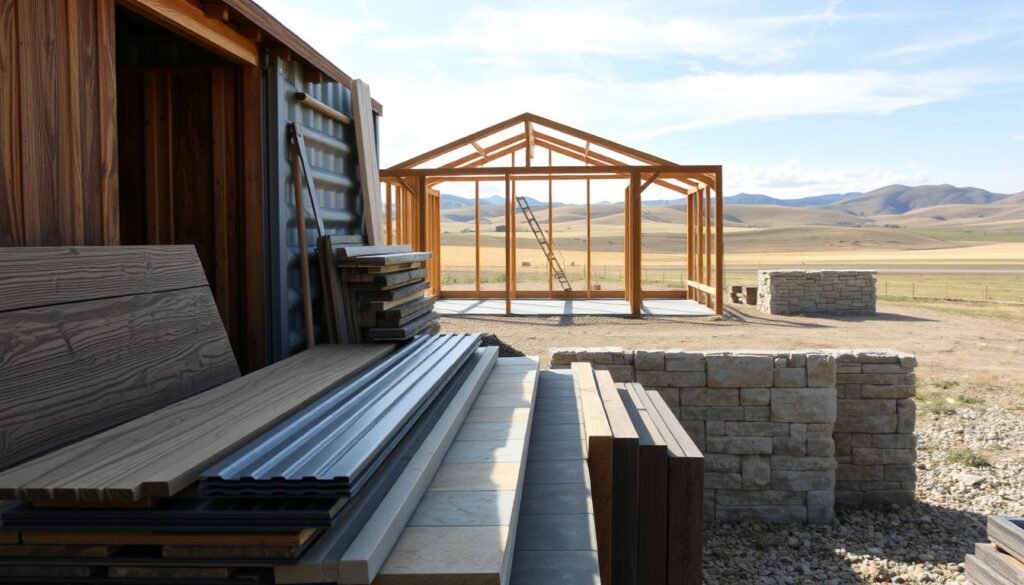
We look at performance, cost, and looks when picking materials for a barndominium. The materials we choose affect how warm or cool the building stays, how long it takes to build, and how much upkeep it needs. We’ll talk about common choices and smart strategies that fit Modern Barndominium ideas. We also keep durability and cost in mind.
Popular building materials for Barndominiums
Steel cladding and structural steels are great for quick building and big open spaces. These are key in many Modern Barndominium ideas. Post-frame timber systems offer a cozy, flexible shell and pair well with wood features like cedar posts for porches.
Hybrid assemblies combine metal panels with wood trim for strength and looks. Prefabricated metal systems cut down on site work. Post-frame systems are cheaper upfront and make adding on easier later.
Eco-Friendly Options
Choosing insulation is key for energy use over time. Options like engineered insulated slabs, spray foam, cellulose, and high-R batt insulation fit different climates and budgets. We suggest using natural light, shading, and high-performance windows to cut down on heating and cooling needs.
Using 3D models helps test how well a building will get sunlight and perform before it’s built.
Cost-Effective Choices
Choosing the right build package is important for material strategy. A Shell (DIY) package lets owners save money by doing the labor themselves. A Shell+ package includes engineered parts to lower risks and can get better prices by quoting suppliers directly.
Opt for durable, easy-to-maintain cladding in standard sizes to avoid extra costs. Having detailed plans from the start helps avoid costly changes during construction.
We offer advice on picking materials that balance durability, warmth, and cost. Our advice fits common build packages and supports Modern Barndominium ideas. It doesn’t sacrifice buildability or long-term value.
Common Mistakes to Avoid
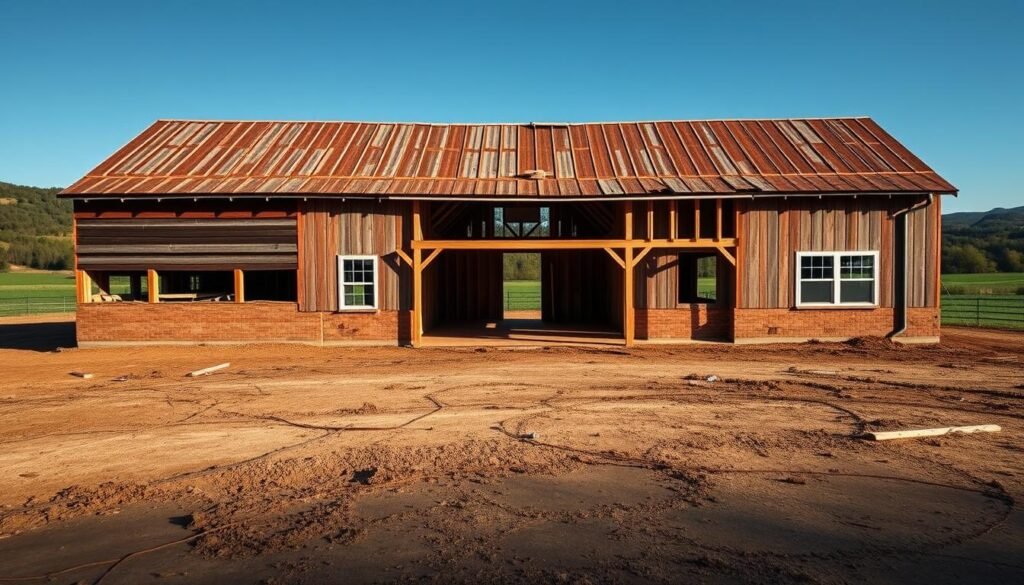
Projects often hit roadblocks early on. Knowing common pitfalls helps avoid delays and stay on budget. We’ll discuss key risks and how to avoid them.
Skipping the Planning Stage
Rushing to start construction is a big mistake. Skipping planning can lead to incomplete plans and permit issues. We use a structured approach: Exploration, Commitment, Preparation, Execution.
Starting with early engineering coordination helps avoid delays and costly changes. Including structural and permit details early saves time. Companies like Barndo & Co. and JL focus on planning to keep projects on track.
Underestimating Costs
Underestimating costs is a common error. Use $100–$150/sf as a starting point, and $200+/sf for luxury finishes. Always add extra for unexpected costs.
Mistakes during construction can increase costs by 5–10x. Choose the right build service based on your ability. Unexpected delays or labor shortages can quickly raise costs.
Ignoring Local Building Codes
Ignoring local codes causes delays and re-submissions. Plans without code details often get rejected. Early engagement with local authorities helps speed up approvals.
Having code-compliant plans is key. Services like Barndo Plans offer architectural and structural stamping. This ensures your project meets codes, protecting your schedule and budget.
Our advice includes detailed planning, accurate budgeting, and code-focused plans. Engaging authorities early helps avoid common risks. Follow these steps to keep your barndominium project on track.
Finding the Right Professional Help
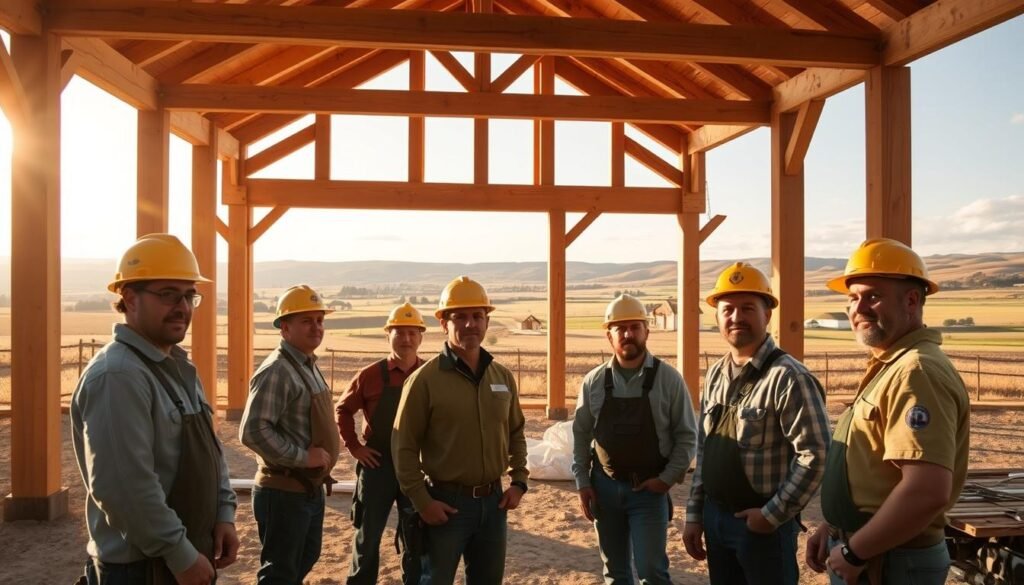
Starting a successful build begins with the right team. Working together early saves time and avoids surprises. This guide helps you find experts in barndominium systems to get your project ready for permits.
Choosing an Architect or Designer
When picking an architect, look for those with barndominium experience. JL Barndominium Artists, Barndo Plans, and Barndo & Co. are known for quick work. Check their portfolios for projects like yours.
Choose teams that communicate well and offer unlimited changes. This keeps your design flexible and within budget. Ask about their timeline for reviews and final plans.
Working with Engineers
Get a structural engineer on board early. Barndo Plans works with Consac LLC for plans that meet local codes. They help with load calculations and foundation design to avoid delays.
Make sure the engineer can stamp your drawings. This step prevents last-minute changes and keeps your project on track.
The Importance of Contractor Selection
Choose contractors who know your framing type. Many builders are part of networks like JL and Barndo & Co. They have crews familiar with barndominium systems. This saves time on site.
Make sure your contract is clear. Define what’s included, who buys materials, and warranty terms. Use clear pricing to avoid surprises. This builds trust and keeps costs in check.
Assemble a team: an architect, engineer, and contractor. Working together early ensures a smooth build, permits, and a better budget.
Navigating Zoning and Permits
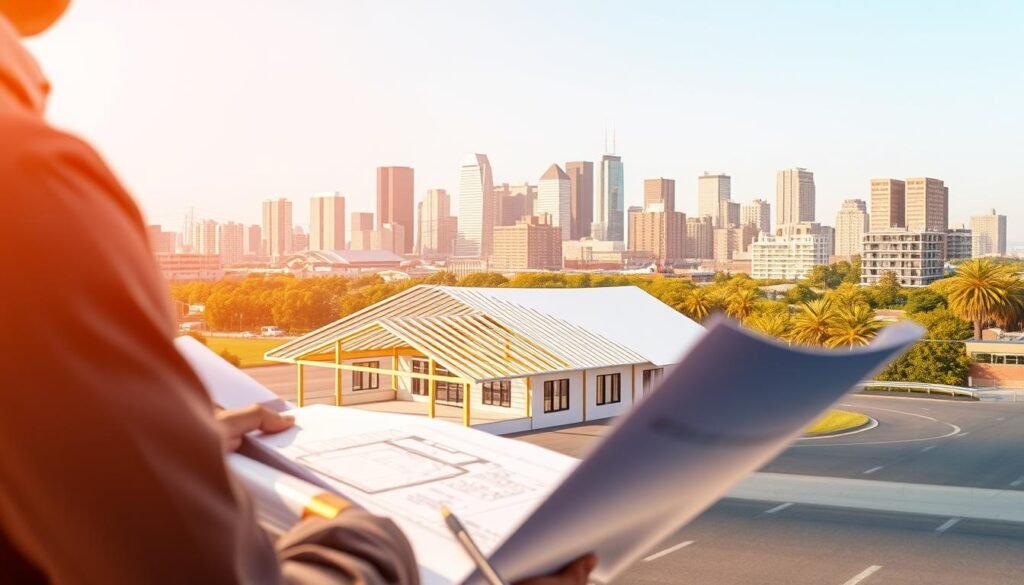
Zoning maps, permit offices, and local codes tell us what we can build. Knowing about zoning and permits for Barndominiums saves time and keeps designs realistic. We guide teams and owners through the process to avoid surprises.
Understanding local regulations
Zoning rules cover allowed uses, setbacks, height limits, and more. We check if the land is zoned for agriculture, homes, or mixed-use before planning. Knowing these rules is key to avoid problems later.
We suggest checking land-use during the early stages. This helps avoid costly redesigns and ensures plans fit neighborhood rules. Local planning departments can confirm what’s allowed and if variances are needed.
Obtaining necessary permits
Permit packages need detailed plans, site maps, and energy forms. Clear submissions help speed up reviews and reduce comments. This makes the process smoother.
Permit times vary by area. We plan for fees and possible resubmissions. Being ready with soil reports, foundations, and energy calculations helps get approvals faster.
Working with local authorities
Talking to permit officials early helps. Pre-app meetings can uncover code issues and needed attachments. Quick responses to requests keep the process moving.
We use experienced plan providers to meet local standards. This builds good relationships with inspectors and reviewers. It makes getting permits easier.
| Stage | Key Documents | Action |
|---|---|---|
| Site Assessment | Zoning map, parcel report, topography | Confirm allowed uses and setbacks with planning office |
| Design Development | Stamped architectural plans, structural drawings | Align plans with local code and energy requirements |
| Permit Submission | Complete permit packet, site plan, compliance forms | Submit to permit office and track review timelines |
| Review & Revisions | Supplemental pages, engineer responses, clarifications | Address reviewer comments promptly to avoid delays |
| Final Approval | Issued building permit, inspection schedule | Coordinate inspections and begin construction |
Customizing Your Barndominium Design
We find the perfect mix of bold style and smart design. Custom Barndominium designs blend tough utility with cozy living areas. We guide you in adding special touches, creating a unique look, and planning for the future.
Adding Unique Features
Clear-span bays and mezzanines offer flexible workspaces. Big garage doors and built-in utility areas are great for hobbies and small businesses.
3D renderings help us check how spaces work before we build. This step avoids costly mistakes and makes sure rooms flow well.
We add useful extras like EV charging and strong finishes where they’re needed most. These choices make your home better to live in and more valuable when you sell it.
Branding Your Space
We pick materials that make a statement, like metal and cedar or modern metal with rustic wood. These choices give your home its unique feel.
We make sure every part of your home looks like it belongs together. This creates a look that’s easy to recognize and feels intentional.
Future-Proofing Your Design
We design with flexibility in mind. We leave room for future additions and solar panels on the roof. This way, your workshop can easily become living space later.
We use strong slabs, solid framing, and easy-to-reach mechanical areas for easy upgrades. These features save money and hassle when you need to make changes.
We believe in designing with both style and future needs in mind. This way, your home stays beautiful and functional for years to come.
| Focus Area | Design Tactics | Long-Term Benefit |
|---|---|---|
| Workshop Integration | Clear-span bays, mezzanines, oversized doors | Flexible use, high resale appeal |
| Utility Planning | EV charging, integrated utility bays, durable finishes | Operational efficiency, lowered maintenance |
| Visual Identity | Metal siding with cedar accents, consistent elevations | Strong curb presence, cohesive branding your space |
| Adaptability | Reserved structural capacity, mechanical chases | Easy future conversions, future-proofing design |
| Verification | 3D renderings and phased reviews | Reduced surprises during construction |
Popular Barndominium Styles
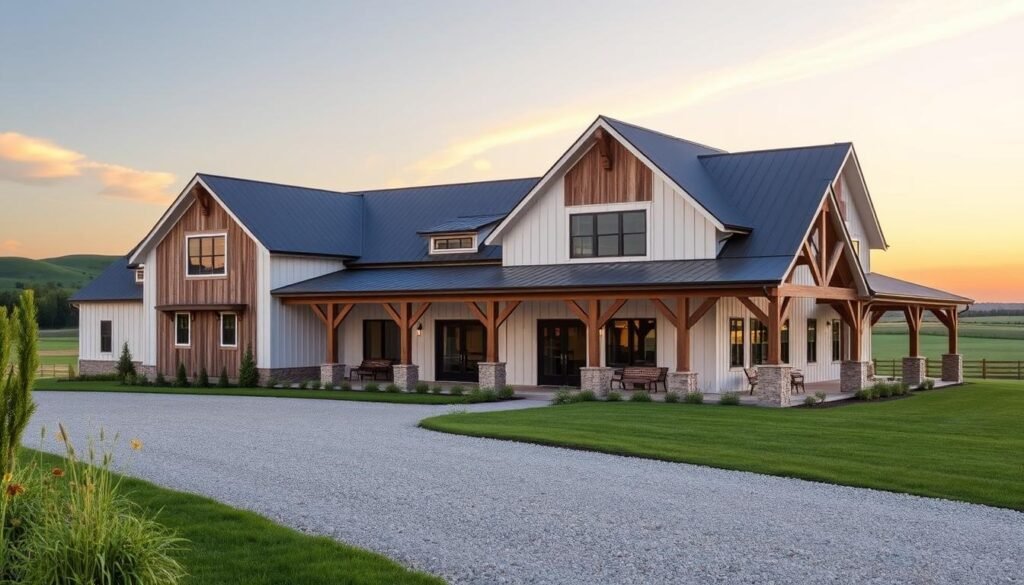
We identify three main styles to help teams pick the right look for their project. Each style combines beauty with practicality and building efficiency.
Modern Barndominiums
Modern Barndominiums are all about simplicity and openness. They use big windows, metal siding, and little decoration for a sleek look.
Designers like JL and Barndo Plans focus on smart layouts and modern touches. They use advanced materials for better energy use and comfort.
Rustic Designs
Rustic designs highlight natural wood, cedar posts, and big porches for a cozy feel. They use timber framing and natural materials for a homemade look.
Many projects mix steel with wood for strength and beauty. Builders and contractors often focus on porches and wood details as key features.
Industrial Inspirations
Industrial designs feature metal, high ceilings, and visible structure. They’re perfect for those needing big spaces or mixed-use areas.
They use strong, easy-to-care-for materials and simple building methods. This results in a practical look that’s both functional and budget-friendly.
We show these styles to help teams balance looks, structure, and cost. Choosing between Modern, Rustic, and Industrial styles ensures design meets real-world needs.
Final Thoughts on Custom Barndominium Plans
Custom plans connect our dreams with solid construction. They make sure everything fits together perfectly. Companies like Barndo Plans, Barndo & Co., and JL Barndominium Artists focus on building that lasts. This approach means fewer surprises and more happiness in the long run.
Looking at inspiring Barndominium examples can guide us. We see modern metal homes, cozy porches, and open spaces. These designs teach us about size, materials, and how to move around inside. Projects from Weatherford and Driftwood, along with 3D views and client feedback, show us what’s possible.
Starting a project means getting to know your land, setting a budget, and choosing between ready-made or custom designs. It’s smart to talk to engineers and get permits early. Barndo & Co. suggests a first meeting and offers help with money and property. For more information or to start designing, email info@barndoplans.com or call +1-844-963-9963. Look for builders who provide detailed plans, endless changes, and help with permits.
In conclusion, a good plan turns dreams into a strong, valuable home. With the right knowledge and builders, we can make it happen. Start small, use what others have learned, and move forward step by step.
